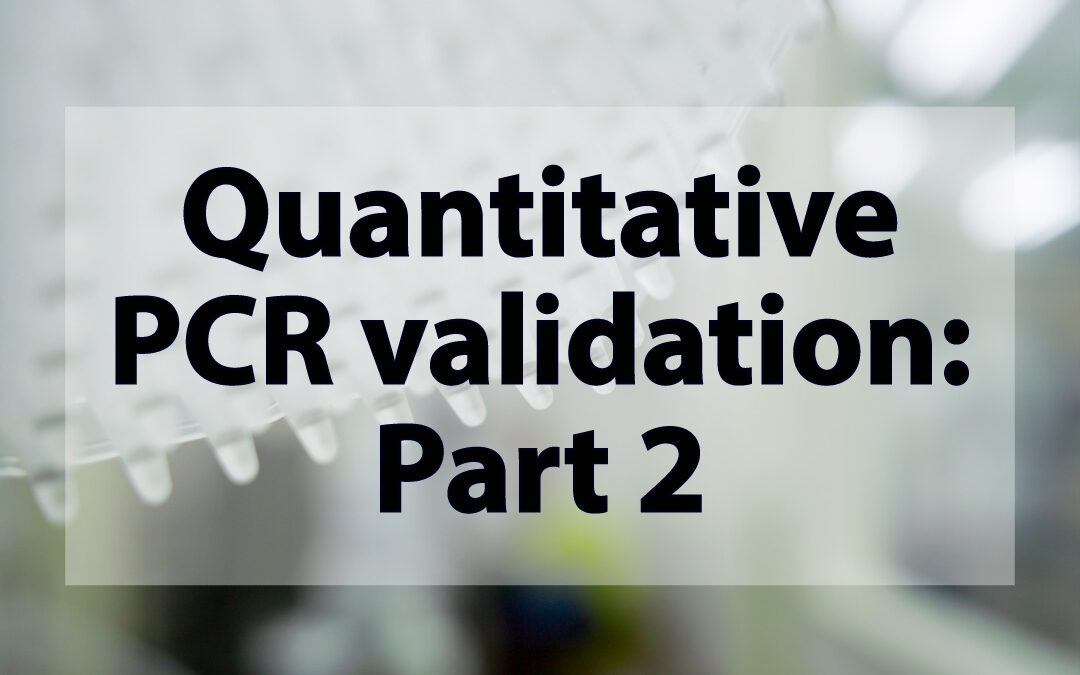A two-part primer in quantitative PCR validation
This two-part article discusses the validation of quantitative PCR (qPCR) assays and why validation is essential for you as a research scientist to have confidence in your data. This discussion includes clear and concise explanations of key terms used in qPCR assay validation.
In part one, we addressed inclusivity, cross-reactivity, and linear dynamic range. Here in part two, we discuss limit of detection, limit of quantification, assay precision, and assay accuracy.
Limit of detection and limit of quantification
Any quantitative assay will have limits beyond which confidence in the data breaks down. In Part 1 of this series, we discussed the linear dynamic range; in the case of PCR, the range over which the input (template genetic material) and output (fluorescence signal) have a linear relationship.
The limit of detection and the limit of quantification are two related concepts focused on the smallest amount of a measurement (input, DNA in our case) that can be detected with confidence (limit of detection, “there’s something there”) or quantified with confidence (limit of quantification, “there’s something there and we know how much”).
The Clinical Laboratory Standards Institute (www.clsi.org) defines limit of detection and limit of quantification as:
Limit of detection = the lowest amount of analyte (measurand) in a sample that can be detected with (stated) probability, although perhaps not quantified as an exact value.
Limit of quantification = the lowest amount of measurand in a sample that can be quantitatively determined with {stated} acceptable precision and stated, acceptable accuracy, under stated experimental conditions
It’s important to calculate and report the limit detection quantification so that researchers can make an informed interpretation of the results. Reporting these values also helps with inter-laboratory comparisons.
How to calculate the limit of detection for qRT-PCR assays
Because qRT-PCR is a quantitative method (the clue is in the name), it’s best to use the limit of quantification as the lower limit of the assay (not the limit of detection).
Readers might be familiar with some of the conventional methods for arriving at the limit of detection. However, qRT-PCR breaks some of the assumptions of these methods, making them unsuitable. This has led to authors developing various sophisticated mathematical methods for calculating the limit of quantification for qRT-PCR assays. The more mathematically-minded readers are encouraged to read further (Forootan et al. and Nutz et al.). But, for the more practical among us, it’s possible to consider the limit of quantification as the point at which the Ct value stops being co-linear with the input. Let’s consider this further:
You have a standard sample with a known concentration of template. You make a dilution series and use these dilutions in a qRT-PCR assay. Then, for each dilution, you plot the Ct value against the template concentration. As you move down the dilutions (from most concentrated to more dilute), your Ct values will increase linearly (higher Ct = less signal/template). But when you reach the lowest-concentration dilutions, the Ct values will eventually stop being co-linear with the template concentration. The lowest dilution that maintains linearity can be considered the limit of quantification.
Note: the limit of quantification is also the bottom of your linear dynamic range (see Part 1 of this 2-part series).
Assay accuracy and precision
An assay’s accuracy, or trueness, is assessed by how close an experimental measurement is to the true value. The closer a measurement is to the true value, the more accurate it is. The variation between individual measurements of a given sample determines precision. Less variation between measurements means greater precision.
Precision is further divided into repeatability, which is referred to as short-term precision or intra-assay variance, and reproducibility, which is also referred to as long-term precision or inter-assay variance. Repeatability is determined by the difference between repeated measurements of the same sample in the same assay, whereas reproducibility is determined by the precision of measurements in separately executed assays. Again, less variation means greater repeatability or reproducibility.
The assay repeats can be done in the same laboratory or different laboratories to assess reproducibility. However, if carried out in the same laboratory, the assays should ideally be done on different days, by different operators, using different instruments, if possible. For qPCR assays, while Ct values are suitable for assessing repeatability, it is better to compare template concentrations than Ct values when assessing reproducibility (inter-assay variance), as Ct values are prone to significant variation from one run to the next.
VRS qPCR services
Given the intricacies and nuances of qPCR, it can be a daunting task to understand, let alone complete a quality qPCR project. With a focus on viral detection and quantification, VRS offers a wide range of qPCR services. We can develop and fully validate your assay so that you can have confidence testing even your most precious samples. Get in touch with us and consider outsourcing your qPCR needs to VRS to save time and achieve full confidence in your results.
Blog by Farrell MacKenzie
Edited by Reckon Better Scientific Editing




